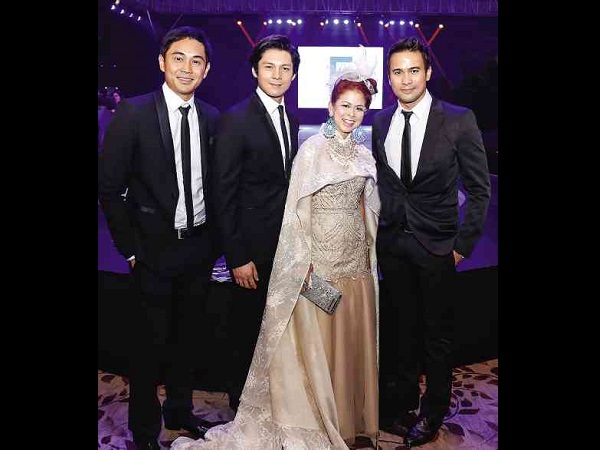
To have a dress made so exquisite and beautiful, and to wear it only once, only to stash it in a box thereafter, is unacceptable to designer Oj Hofer.
In a rather forward-thinking interpretation of Inquirer Lifestyle and Samsung’s “2013 Face-off” theme in Cebu last weekend, the Cebuano fashion designer presented two bridal looks that any bride can wear again on special occasions other than her wedding.
“I think it’s démodé to have something made that you can’t wear again,” said Hofer, one of 21 featured bridalwear designers, interpreting the theme “Tomorrow’s Classics Today.” “That’s just wasteful,” he added.
“2013 Face-off,” the fifth year of the series, is a virtual runway showdown of the fashion industry’s best, and comes on the heels of last year’s largest gathering of bridalwear designers in a single show yet, numbering 40. Co-presented with LOOK Magazine and Radisson Blu Cebu, this year’s “Face-off” had 10 designers from Manila and 11 from the host city.

(In the same event, Samsung also introduced its latest smartphone, the Galaxy S4 Zoom, which was debuted in London only a few weeks prior.)
Without a doubt, the designers from the Queen City, including Hofer, held their own against their Manila counterparts, especially when it came to intricate details and superb craftsmanship.
Hofer’s first look was a bias-cut, silk gazar pantsuit paired with a sculptural top of the same material. As its designer suggested, either piece can be worn separately to create a new look, the draped top for one easily winning fans in the audience.
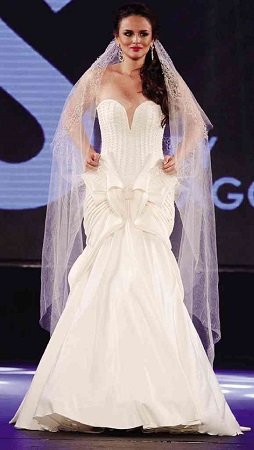
Artist
“He’s an artist, you can tell,” said fellow designer Cary Santiago of Hofer’s fluid draping. “That top was like a sculpture.”
Hofer also presented a thin-strapped slinky dress with flat pailletes, worn with a gossamer opera coat to give it that drama that brides typically ask for, he said. “After the wedding, you can wear that dress on its own, or that coat over a mini dress, and you’ve got yourself a cocktail wear,” the designer noted.
Admittedly, Filipina brides still opt for the typical pretty-princess styles, said Hofer, who has been designing for over 20 years. “But some are now more practical,” he added. “It hasn’t changed drastically, but more and more are taking chances.”
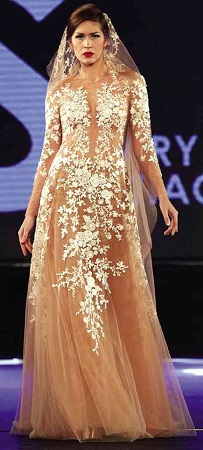
Which was perhaps why Protacio Empaces was emboldened to design two pantsuits inspired by Bianca Jagger’s 1971 Le Smoking wedding number, instead of frothy confections.
“As we become more environment-conscious, pants will become very relevant and practical,” Empaces said. “Cars will become smaller, and it will be impossible to wear petticoats.”
While no bride has asked him for a pantsuit, Empaces has been receiving requests for easy-to-wear and shorter wedding dresses, perhaps also in keeping with the destination-wedding trend, he said.
His first look had a Swingin’ ’60s feel, hand-embroidered cashmere wool topped with a pillbox-inspired hat. The second, more a nod to the 1950s, was a bustier and trousers made of tulle and Mikado silk.
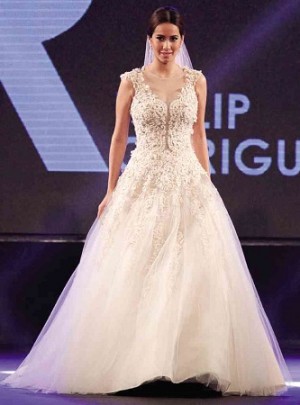
“Before, I used to have designs ready for brides to choose from,” said Empaces, who started designing in 1987. “Now they come to me with their own pegs. And it’s no longer magazine cutouts; they come with their iPads!”
Philip Rodriguez showed two designs that cater to his target market: the romantic bride. One was a study in silk ribbons woven into the bodice like the solihiya; it’s an homage to the once-popular wicker-furniture industry of Cebu. The other was a more traditional wedding dress of Alençon lace over a nude tulle bodice with blush-pink florets and a matching veil.
“My brides still go for the romantic look,” said Rodriguez, a Cebu fashion institution. “Once in a while, they will experiment. For instance, in the beadwork. Recently I had a bride who wanted a ‘Great Gatsby’-inspired dress, so we did Art Deco beadwork. It helps to work with brides who have their own opinions.”
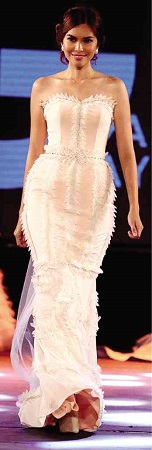
Arcy Gayatin gave two contrasting options for future brides. The first—a fishtail gown in white chiffon with pink lining, embellished with cut pieces of tulle arranged in a chevron pattern—showed what the designer calls her “usual experimental details.”
Detachable
Her second look was a mini dress with a tulle overlay, because her brides usually want something detachable for the reception. “Most brides now don’t want just something they put in a box after the wedding,” she said. “They want to get the most wear from it.”
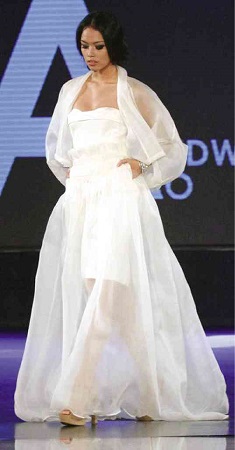
For his part, Edwin Ao chose to send out his nod to the baro’t saya, and another inspired by costumes from films during the Sampaguita Pictures era.
Ao’s modern baro’t saya consisted of a strapless top, knee-length skirt, and a sheer floor-length coat that was softly sculptured on the back. The film-inspired dress was a deconstructed two-piece number in a combination of reworked barong Tagalog fabric and Thai silk. Styling it with opera-length gloves, Ao draped a pleated fabric accent on the slender skirt.
“Brides today are open to experimentation, but only when it comes to the techniques,” he said. “In the end, they still go for traditional silhouettes.”
Jun Escario, who is as popular in Manila as he is in his native Cebu, showed two contrasting looks of the same Spanish influence. One was reminiscent of the flamenco dress, with French lace over the nude lining on the bodice, and tiers of tulle on the mermaid skirt.
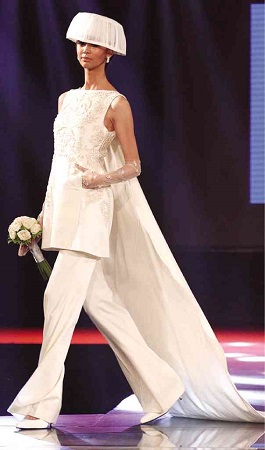
Best known for feminine and romantic bridalwear, he made a full-skirted dove-gray number for the second look. It had a fully beaded top, its demure sleeves reaching the elbows. He said his brides of late are starting to opt for color, with lavender and pale blue as two recent choices.
“I’m not too experimental, but you can count on me to make something tasteful,” Escario said. “I try to distract brides from frou-frou. That’s not me. I like lightweight gowns. That first look, it’s paper-light and very easy to wear.”
If Escario is all about elegant understatement, Philip Tampus is all about high drama. The Middle East-trained Cebuano created two Edwardian-inspired confections: high-neck and bustle, in the rich palettes of burgundy, champagne and matte gold. His sensibility has charmed the likes of Tessa Prieto-Valdes, one of Tampus’ loyal clients.
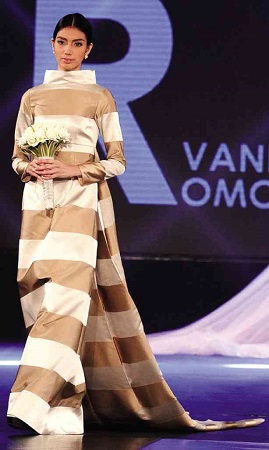
“You see volume in my dresses, but they’re actually very light,” he said. His “Face-off” gowns were done in just a week—and all by his lonesome—as he couldn’t disrupt his shop’s normal operations. His second dress, which had layers upon layers of tulle on the fishtail skirt, were frayed at the hem to create a lightweight and feathery effect. “Each layer was tucked by hand,” he noted.
Tampus settled back in Cebu after his stint on the first season of “Project Runway Philippines”; he had worked for over 10 years as a fashion designer in Saudi Arabia. Michael Cinco was his coworker in Dubai way before Cinco set up his own fashion house. Tampus said he’s pleased that Filipino designers who had worked in the Middle East are getting recognized back home.
Innovate

“The big challenge here is that we don’t have the materials that are available to designers in the Middle East,” Tampus said. “But we know how to innovate. We know how to experiment.”
The clothes of the “2013 Face-Off” designers were sent out on the runway alphabetically. But nobody took issue that the honor of doing the finale went to Cary Santiago, arguably Cebu’s biggest fashion star since his homecoming in 2005. Like Tampus, he honed his craft in the Middle East.
Santiago’s first look was a demure dress of nude couture silk tulle strewn with lace floral appliqués from veil to skirt. The designer said he didn’t expect the audience to guess that that dress would come from him.
“I wanted to try something soft, which I never get to do because people come to me for my usual fabric-manipulation techniques,” Santiago said. The dress looked deceptively simple compared to his usual complex fabric manipulations, but it actually involved similar amount of work, according to the designer. He used three kinds of lace just to cut out the flowers and leaves and arranged them like a puzzle to create his desired bouquet pattern.

Guests hoping to see his signature origami folds weren’t, however, disappointed, as Santiago’s finale dress was exactly that. The dress worn by Georgina Wilson had a bustier that featured basket-weave patterns and his distinct folds and pleating.
Santiago, who’s marking his 25th year in the industry in 2014, was generous in his praise for his fellow designers. Apart from Hofer, he also gave his nod to Escario’s soft and feminine silhouettes, as well as Joey Samson’s “impeccable tailoring.”
Rounding up the Cebu 11 were William Manahan, Dino Lloren and Vania Romoff.
Manahan had two romantic dresses—one was a silver-belted, iridescent number with floral appliqués on the hem, its straps held together by the same floral cutouts. His second look sported tiny floral accents all over the bodice, and was cinched with a black sash.
Lloren sent out two rather cheeky bridal looks. The designer had his first model take the catwalk with her bottom undergarment deliberately displayed through the sheer skirt, as if a counterpoint to the somewhat modest, lacy long-sleeved top. It seems these were Lloren’s nod to the recent sheer-skirt trend, as his second design, a taupe number with a sequined strapless top, featured the same see-through treatment.
Romoff, one of Cebu’s rising stars, presented two contrasting looks. One was a long-sleeved, high-collared number in two-tone gold horizontal stripes, with a short train of the same material. The other was a far less demure, slinky white jersey dress with bell sleeves.
While the sedate silhouette of the first look conjured images of some highborn woman, the second brought mental images of Victor Hugo’s gypsy dancer Esmeralda as a bride.

